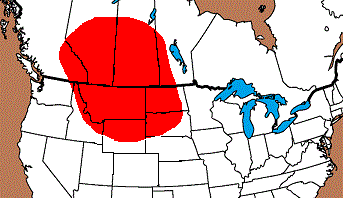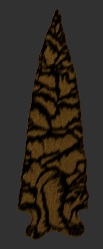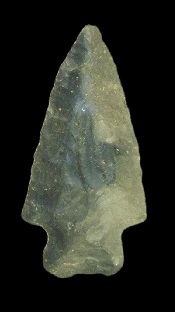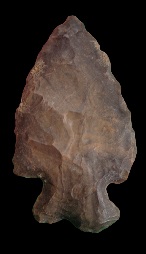Outline is Representative of Size and Shape:

Name Details:
Identified By: Raymond C. Bentzen
Named For: Type Site
Date Identified: 1961
Type Site: Powers-Yonkee Bison Trap site (24PR5), Powder River Valley County, Montana
Identified By: Raymond C. Bentzen
Named For: Type Site
Date Identified: 1961
Type Site: Powers-Yonkee Bison Trap site (24PR5), Powder River Valley County, Montana
Point Validity:
Valid type
Benten was a renowned anthropologist who was an expert in the archaeology of the Northern Plains region. He conducted extensive studies and excavations through-out that region. This point was named in a professional publication and has many professional references. This is considered a valid type.
Benten was a renowned anthropologist who was an expert in the archaeology of the Northern Plains region. He conducted extensive studies and excavations through-out that region. This point was named in a professional publication and has many professional references. This is considered a valid type.
Yonkee Notched
Cluster: McKean Cluster Description of Physical Characteristics and Flaking Pattern:
This is a long slender medium triangular expanding stem point with an elliptical cross section. The blade has an excurvate shape. The shoulders may vary from angling downward, to barbed. The stem is expanding, and the base is notched or thinned creating an obvious basal concavity. This point has a random flaking pattern.
Size Measurements:
Total Length - 40 to 70, Stem Length - 8 to 12 mm, Blade Width - 18 to 27 mm, Neck Width - 12 to 17 mm, Stem Width - 17 to 21 mm (typically 10% less than blade width) (***based on small sample size***).
Total Length - 40 to 70, Stem Length - 8 to 12 mm, Blade Width - 18 to 27 mm, Neck Width - 12 to 17 mm, Stem Width - 17 to 21 mm (typically 10% less than blade width) (***based on small sample size***).
Commonly Utilized Material:
Additional Comments:
This complex has five main points associated with it. The McKean point, Duncan Point, Hanna Point, Mallory, and the Yonkee point.
This point is thought to be the terminal phase of the McKean complex (Bentzen, 1962).
Often confused with the Hanna point.

* Southsider Var. represents continuum between the McKean and Duncan point. This type is commonly typed as a McKean or Duncan depending on the degree of lateral edge restriction. Also called Shouldered McKean.
** The Duncan point is also referred to as Shouldered McKean
This complex has five main points associated with it. The McKean point, Duncan Point, Hanna Point, Mallory, and the Yonkee point.
This point is thought to be the terminal phase of the McKean complex (Bentzen, 1962).
Often confused with the Hanna point.

* Southsider Var. represents continuum between the McKean and Duncan point. This type is commonly typed as a McKean or Duncan depending on the degree of lateral edge restriction. Also called Shouldered McKean.
** The Duncan point is also referred to as Shouldered McKean
Distribution:
Distribution Comments:
This point is a plains point that is primarily found on the Northern Plains. It is found most commonly in Canada, it has been found into the upper Plains states.
This point is a plains point that is primarily found on the Northern Plains. It is found most commonly in Canada, it has been found into the upper Plains states.
Age / Periods:
Date: 3,100 - 2,300 B.P.
Cultural Period: Late to Transitional Archaic
Glacial Period: Neoglacial
Environmental: Sub-Boreal
Culture:
Date: 3,100 - 2,300 B.P.
Cultural Period: Late to Transitional Archaic
Glacial Period: Neoglacial
Environmental: Sub-Boreal
Culture:
Age Details:
The appearance of Duncan and McKean points mark the onset of the McKean phase (ca. 3000 to 1500 B.C.E.) A number of archaeologists have suggested that Duncan was the predominant point type in the complex between circa 2000 and 1500 B.C.E. (e.g., Reeves 1970a:74; Brumley 1975:72–73). (Morrow, 2016)
The appearance of Duncan and McKean points mark the onset of the McKean phase (ca. 3000 to 1500 B.C.E.) A number of archaeologists have suggested that Duncan was the predominant point type in the complex between circa 2000 and 1500 B.C.E. (e.g., Reeves 1970a:74; Brumley 1975:72–73). (Morrow, 2016)
Other points in this cluster / Related / Associated Points:
Duncan, Hanna, Hanna Northern, Mallory, McKean
Duncan, Hanna, Hanna Northern, Mallory, McKean








